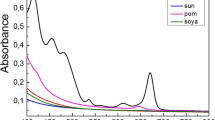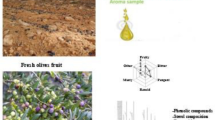Abstract
The appearance of most of the commercialized olive oils involves both their color and turbidity depending on the different technologies used for their elaboration. This research has been carried out to study the filtration impact on the colorimetric changes of virgin olive oils. Naturally turbid olive oils were blended at different proportions (100, 80, 60, 40, 20 and 0%) with their corresponding filtered replicates to obtain a scale of six levels of turbidity and simulating different turbidity grades. Tristimulus colorimetry, particularly the CIELAB uniform color, was used to follow color changes. As turbidity of the oil increased in the blend, yellowish oils, darker, and less saturated were obtained. Univariate correlations between the colorimetric parameters and turbid content were achieved with second degree polynomial equations, being chroma (\( C_{{_{\text{ab}} }}^{ *} \)) and hue (h ab) the best correlated parameters. The color differences (\( \Updelta E_{{_{\text{ab}} }}^{ *} \)) calculated between turbid oils (100%) and the consecutively decreasing turbid oils blends ranged from 3.18 to 18.72 CIELAB units, revealing differences in color visually perceptible to the human eye.






Similar content being viewed by others
References
Calvo C, Salvador A, Fiszman SM (2001) Influence of colour intensity on the perception of colour and sweetness in various fruit flavoured yoghurts. Eur Food Res Technol 213:99–103
Hutchings JB (1999) Food colour and appearance, 2nd edn. Aspen Publishers, Gaithersburg
EEC (1991) Characteristics of olive and olive pomace oils and their analytical methods. Regulation EEC/2568/91 ad later modifications. Official J Euro Communities L248:1–82
IOOC (2006) International Trade Standard Applying to Olive Oils and Olive-Residue Oils (COI/T.15/NC no. 3/Rev. 2), IOOC
Ceballos C, Moyano MJ, Vicario IM, Alba J, Heredia FJ (2003) Chromatic evolution of virgin olive oils submitted to an accelerated oxidation test. J Am Oil Chem Soc 80(3):257–262
Nielsen NA, Bech-Larsen T, Grunert KG (1998) Consumer purchase motives and product perceptions: a laddering study on vegetable oil in three countries. Food Qual Prefer 9(6):455–466
Siskos Y, Matsatsinis NF, Baourakis G (2001) Multicriteria analysis in agricultural marketing: the case of French olive oil market. Eur J Oper Res 130:315–331
Del Giovine L, Fabietti F (2005) Copper chlorophyll in olive oils: identification and determination by LIF capillary electrophoresis. Food Control 16:267–272
Koidis A, Triantafillou E, Boskou D (2008) Endogenous microflora in turbid virgin olive oils and the physicochemical characteristics of these oils. Eur J Lipid Sci Tech 110:164–171
Mili S, Rodríguez-Zuñiga MR, Sanz Cañada J (1997) El sector del aceite de oliva ante la globalización de mercados: reflexiones desde una perspectiva de demanda. Economía Agraria 181:209–242
Angerosa F, Mostallino R, Basti C, Vito R, Serraiocco A (2000) Virgin olive oil differentiation in relation to extraction methodologies. J Sci Food Agr 80:2190–2195
Bottino A, Capannelli G, Mattei A, Rovellini P, Zunin P (2008) Effect of membrane filtration on the flavor of virgin olive oil. Eur J Lipid Sci Tech 110:1109–1115
Hafidi A, Pioch D, Ajana H (2005) Effects of a membrane-based soft purification process on olive oil quality. Food Chem 92:607–613
Lercker G, Frega N, Bocci F, Servidio G (1994) Veiled extra virgin olive oils: dispersion response related to oil stability. J Am Oil Chem Soc 71(6):657–658
Blanco-Roldán GL, Gil-Ribes JA, Kourba K, Castro-García S (2009) Effects of trunk shaker duration and repetitions on removal efficacy for the harvesting of oil olives. Appl Eng Agri 25(3):329–334
Criado MN, Romero MP, Casanovas M, Motilva MJ (2008) Pigment profile and colour of monovarietal virgin olive oils from Arbequina cultivar obtained during two consecutive crop seasons. Food Chem 110(4):873–880
Diraman H, Dibeklioğlu H (2009) Characterization of Turkish virgin olive oils produced from early harvest olives. J Am Oil Chem Soc 86(7):663–674
Malheiro R, Oliveira I, Vilas-Boias M, Falcao S, Bentoa A, Pereira JA (2009) Effect of microwave heating with different exposure times on physical and chemical parameters of olive oil. Food Chem Toxicol 47(1):92–97
Mínguez-Mosquera MI, Rejano-Navarro L, Gandul-Rojas B, Sánchez-Gómez AH, Garrido-Fernández J (1991) Color-pigment correlation in virgin olive. J Am Oil Chem Soc 68(5):332–336
Moyano MJ, Meléndez-Martínez AJ, Alba J, Heredia FJ (2008) A comprehensive study on the colour of virgin olive oils and its relationship with their chlorophylls and carotenoids indexes (I): CIEXYZ non-uniform colour space. Food Res Int 41:505–512
Moyano MJ, Meléndez-Martínez AJ, Alba J, Heredia FJ (2008) A comprehensive study on the colour of virgin olive oils and its relationship with their chlorophylls and carotenoids indexes (II). CIELUV and CIELAB uniform colour spaces. Food Res Int 41:513–521
Pristouri G, Badeka A, Kontominas MG (2010) Effect of packaging material headspace, oxygen and light transmission, temperature and storage time on quality characteristics of extra virgin olive oil. Food Control 21(4):412–418
Sánchez-Gimeno AC, Negueruela AI, Benito M, Vercet A, Oria R (2008) Some physical changes in Bajo Aragón extra virgin olive oil during the frying process. Food Chem 110(3):654–658
Ogutu M, Mendes M, Yilmaz E (2008) Sensorial and physico-chemical characterization of virgin olive oils produced in Canakkale. J Am Oil Chem Soc 85:441–456
Van de Hulst HC (1957) Light scattering by small particles. Wiley, New York
Kerker M (1969) The Scattering of light. Academic Press, New York
Mignani AG, Smith PR, Ciaccheri L, Cimato A, Sani G (2003) Spectral nephelometry for making extra virgin olive oil fingerprints. Sensor Actuat B-Chem 90:157–162
Mignani AG, Ciaccheri L, Cimato A, Attilio C, Smith PR (2005) Spectral nephelometry for the geographic classification of Italian extra virgin olive oils. Sensor Actuat B-Chem 111:363–369
Moyano MJ., Melgosa M, Alba J, Hita E, Heredia FJ (1999) Reliability of the bromothymol blue method for color in virgin olive oils. J Am Oil Chem Soc 437 76(6):687–692
CIE (2004) Colorimetry: technical report CIE15.2, 3rd edn. Vienna, Austria
Heredia FJ, Álvarez C, González-Miret ML, Ramírez A (2004). “CromaLab®, análisis de color”, Registro General de la Propiedad Intelectual SE-1052-04: Sevilla, Spain
StatSoft, Inc. (2007). STATISTICA (data analysis software system), version 8.0. www.statsoft.com
McClements DJ (2002) Theoretical prediction of emulsion color. Adv Colloid Int Sci 97:63–89
Chanamai R, McClements DJ (2001) Prediction of emulsion colour from droplet characteristics: dilute monodisperse oil-in water emulsions. Food Hydrocolloid 15:83–91
Hiemenz PC (1986) Principles of colloid and surface chemistry. Marcel Dekker, New York
McClements DJ (2002) Colloidal basis of emulsion color. Curr Opin Colloid Interface Sci 7:451–455
Chantrapornchai W, Clydesdale F, McClements DJ (1998) Influence of droplet size and concentration on the color of oil-in-water emulsions. J Agric Food Chem 46:2914–2920
Martínez JA, Melgosa M, Pérez MM, Hita E, Negueruela AI (2001) Visual and instrumental color evaluation in red wines. Food Sci Technol Int 7:439–444
Lozano RD (1978) El color y su medición. Ed. Americalee, Buenos Aires
Melgosa M, Pérez MM, Yebra A, Huertas R, Hita E (2001) Algunas reflexiones y recientes recomendaciones internacionales sobre evaluación de diferencias de color. Óptica Pura y Aplicada 34:1–10
Acknowledgments
We are grateful to the Almazara Experimental (Instituto de la Grasa, CSIC, Spain) for having provided the extra virgin olive oil tested. The authors wish to acknowledge the Consejería de Innovación, Ciencia y Empresa (Junta de Andalucía) for the financial support to this work (IAC07-I-1664).
Author information
Authors and Affiliations
Corresponding author
About this article
Cite this article
Gordillo, B., Ciaccheri, L., Mignani, A.G. et al. Influence of Turbidity Grade on Color and Appearance of Virgin Olive Oil. J Am Oil Chem Soc 88, 1317–1327 (2011). https://doi.org/10.1007/s11746-011-1787-y
Received:
Revised:
Accepted:
Published:
Issue Date:
DOI: https://doi.org/10.1007/s11746-011-1787-y




